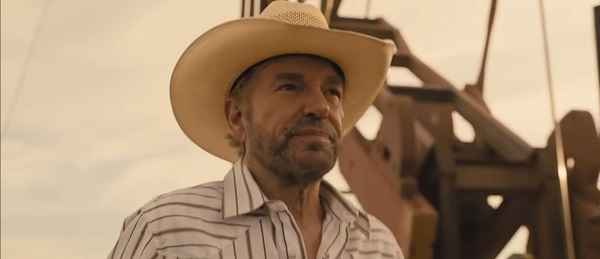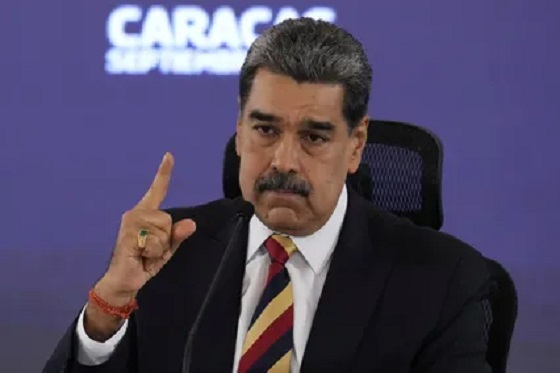Daily Caller
‘Landman’ Airs A Rare And Stirring Defense Of The U.S. Oil-And-Gas Industry

Actor Billy Bob Thornton portraying the character Tommy Norris in an official trailer for the Paramount Plus series “Landman.” (Screen Capture/Landman, Official Trailer, Paramount+)

From the Daily Caller News Foundation
By David Blackmon
Oil companies have always presented easy targets for demonization by the news and entertainment industries. Their operations are highly visible — the flares from a shale well can be seen from many miles distant — the prices they charge for their products can strain family budgets, and they have generally done a lousy job of engaging with the media and defending themselves.
Thus, they typically present the proverbial low-hanging fruit to be exploited by lazy script writers in Hollywood. Those who were in the industry in the early years of the Obama presidency will well remember that pretty much every TV drama series aired at least one episode centered on some highly improbable, often impossible, scenario in which people were killed by a hydraulic fracturing — or “fracking” — accident. Such stuff never happened in real life, but it sure made for compelling entertainment for audiences who did not know that to be the case.
Given this history, it came as no small surprise when the lead character in the new Paramount series “Landman”, the newest offering from “Yellowstone” creator Taylor Sheridan, delivered a stirring 2-minute monologue in defense of America’s oil and gas producers in Episode 3 of the show’s first season. Set in the aftermath of a tragic, fatal Permian Basin oilfield accident that actually could happen in real life, the scene features lead character Tommy Norris, played to near perfection by Billy Bob Thornton, schooling a young, environmentally conscious lawyer who is looking for someone to blame for the accident on the reasons why oil and gas are highly unlikely to be replaced by wind energy in her lifetime.
“You have any idea how much diesel they have to burn to mix that much concrete or make that steel and hold this **** out here and put it together with a 450-foot crane,” Norris says, pointing to a nearby group of 400 ft. wind turbines. “You want to guess how much oil it takes to lubricate that ****ing thing or winterize it? In its 20-year lifespan it won’t offset the carbon footprint of making it. And don’t get me started on solar panels and the lithium in your Tesla battery.”
The monologue goes on for another minute and a half, with Norris detailing all the myriad products made with oil and natural gas, and the fact that, “if Exxon thought them ****ing things right there were the future, they’d be putting them all over the ***damn place.” He isn’t wrong about that last part, by the way. ExxonMobil and its fellow major oil companies like Shell and BP have proven themselves to be pretty much agnostic about the nature of the energy-related projects they’re willing to pursue in recent years.
Those companies and many other traditional oil companies are willing to invest in most any project they believe to be profitable, sustainable and able to deliver strong rates of return to investors. Where wind energy is concerned, both Shell and BP spent years investing heavily in such projects but have been backing away from such investments over the last year as they have failed to produce adequate returns. ExxonMobil, meanwhile, is investing heavily in carbon capture, hydrogen, and even lithium production as part of a growing portfolio of projects in its Low Carbon Solutions business unit.
Back to the Tommy Norris monologue: When I re-posted the clip on LinkedIn and at my Substack newsletter, it went viral, indicating a high level of interest in what Thornton’s character had to say. That may be indicative of a rising recognition of the reality that the US government and global community have in recent years thrown away trillions of dollars in failing attempts to subsidize non-viable, unsustainable, and unprofitable alternatives to oil and natural gas to scale.
Perhaps, then, it is no coincidence that Episode 3 of “Landman” aired on the same day when the media widely reported the COP29 climate conference in Azerbaijan had ended in failure. It also came amid continuing reports that the Trump transition team is developing detailed plans to refocus US energy policy back to Trump’s promised “drill, baby, drill” orientation.
The times are a-changing, and guys like Tommy Norris will look like prophets soon.
David Blackmon is an energy writer and consultant based in Texas. He spent 40 years in the oil and gas business, where he specialized in public policy and communications.
Daily Caller
Trump Reportedly Escalates Pressure On Venezuela With Another Oil Tanker Seizure


From the Daily Caller News Foundation
The U.S. intercepted and seized a vessel in international waters near Venezuela, marking the second such operation in recent weeks, multiple outlets reported Saturday.
The U.S. Coast Guard led the operation with assistance from other branches of the military, U.S. officials told CNN.
The interdiction follows on the heels of the Dec. 10 seizure of a sanctioned tanker off the Venezuelan coast. It also comes just days after President Donald Trump announced a sweeping blockade on all sanctioned oil tankers arriving to or leaving the South American nation, the ruling regime of which he designated a foreign terrorist organization.
Dear Readers:
As a nonprofit, we are dependent on the generosity of our readers.
Please consider making a small donation of any amount here.
Thank you!
“The illegitimate Maduro Regime is using Oil from these stolen Oil Fields to finance themselves, Drug Terrorism, Human Trafficking, Murder, and Kidnapping,” Trump posted Tuesday on Truth Social. “I am ordering A TOTAL AND COMPLETE BLOCKADE OF ALL SANCTIONED OIL TANKERS going into, and out of, Venezuela.”
When asked following the first seizure what the U.S. would do with the confiscated oil, Trump said, “Well, we keep it, I guess.”
The operations come amid months of escalating U.S. pressure on Venezuela.
American armed forces have steadily increased their presence and operations in the southern Caribbean off Venezuela’s coast, including numerous strikes on drug smuggling vessels. The buildup has fueled speculation about a potential full-scale confrontation with Maduro or even a material push for regime change.
Trump reportedly offered Maduro a deal in late November to vacate power in exchange for safe passage for him and his family. The U.S. also placed a $50 million bounty on Maduro in August, the largest sum ever offered for a sitting head of state.
In announcing the blockade Tuesday, Trump warned the “illegitimate Maduro Regime” that the “Armada” surrounding the country “will only get bigger, and the shock to them will be like nothing they have ever seen before.” He also demanded that Maduro “return to the United States of America all of the oil, land, and other assets that they previously stole from us.”
Despite the growing pressure, Maduro dispatched two non-sanctioned vessels Thursday carrying oil to China, Reuters reported.
The Coast Guard referred questions on the operation to the White House, which did not immediately respond to the Daily Caller News Foundation’s request for comment.
Daily Caller
Ex-FDA Commissioners Against Higher Vaccine Standards Took $6 Million From COVID Vaccine Makers


From the Daily Caller News Foundation
By Emily Kopp
The FDA old guard criticized the new leadership in a Dec. 3 New England Journal of Medicine (NEJM) letter over a higher regulatory bar for vaccines, namely the expectation that most new vaccine approvals will require randomized clinical trials, arguing it could hamper the market.
“Insisting on long, expensive outcomes studies for every updated formulation would delay the arrival of better-matched vaccines when new outbreaks emerge or when additional groups of patients could benefit,” the former commissioners wrote. “Abandoning the existing methods won’t ‘elevate vaccine science’ … It will subject vaccines to a substantially higher and more subjective approval bar.”
But while the former commissioners disclosed their conflicts of interest to the medical journal — per standard practice in scientific publishing — reporters didn’t relay them to the broader public in reports in the Washington Post, STAT News and CNN.
The headlines about a bipartisan rebuke from former occupants of FDA’s highest office give the impression that the Trump administration is contravening established science, but closer inspection reveals a revolving door between pharmaceutical corporations and the agencies overseeing them.
Three of the signatories have received payments totaling $6 million from manufacturers or former manufacturers of COVID vaccines.
Scott Gottlieb has received $2.1 million in cash and stock from his position on the Pfizer board of directors, where he has advised on ethics and regulatory compliance since 2019, according to company filings to the Securities and Exchange Commission. Stephen Ostroff has received $752,310 from Pfizer in consulting fees since 2020, according to OpenPayments.
Mark McClellan has received $3.3 million from Johnson & Johnson as a member of the board of directors since 2013, SEC filings also show. McClellan also consults for the new pharmaceutical arm of the alternative investment management company Blackstone, which invested $750 million in Moderna in April 2025.
Gottlieb and McClellan did not respond to requests for comment. Ostroff could not be reached for comment.
FDA Center for Biologics Evaluation and Research Director Vinay Prasad outlined the higher standards and shared the results of an internal analysis validating 10 reports of children’s deaths following the COVID-19 vaccine in a Nov. 28 memo to staff. He called for introspection and reform at the agency.
The NEJM letter criticizes Prasad for cracking down on a practice called “immunobridging” that infers vaccine efficacy from laboratory tests rather than assessing it through real-world reductions in disease or death. The FDA under the Biden administration expanded COVID vaccines to children using this “immunobridging” technique, extrapolating vaccine efficacy from adults to children based on antibody levels.
Norman Sharpless — who in addition to previously serving as acting FDA commissioner also served as the head of the National Institutes of Health’s National Cancer Institute — consults for Tempus, a company that collaborates with COVID vaccine maker BioNTech. He has helped steer $70 million in investments in biotech through a venture capital firm he founded in November 2024. Sharpless also disclosed $26,180 in payments in 2024 from Chugai Pharmaceutical, a Japanese pharmaceutical company that markets mRNA technology among other drugs, on OpenPayments.
“I was grateful for the opportunity to serve as NCI Director and Acting FDA Commissioner in the first Trump Administration, and strongly support many of the things President Trump is trying to do in the current Administration,” Sharpless said in an email.
Margaret Hamburg, another former FDA commissioner and signatory of the NEJM letter, has since 2020 earned $2.8 million as a member of the board of Alnylam Pharmaceuticals, which markets RNA interference (RNAi) technology.
Hamburg did not respond to a message on LinkedIn.
Most signatories disclosed income from biotech companies testing experimental cancer treatments. These products could face tighter scrutiny under Prasad, a hematologist-oncologist long wary of rubberstamping pricey oncology drugs — which Prasad points out often cause some toxicity — without plausible evidence of an improvement in quality of life or survival.
The former FDA commissioners disclosed ties to Sermonix Pharmaceuticals Inc.; OncoNano Medicine; incyclix; Nucleus Radiopharma; and N-Power, a contractor that runs oncology clinical trials.
Andrew von Eschenbach, who like Sharpless formerly served both as FDA commissioner and the head of the National Cancer Institute, disclosed stock in HistoSonics, a company with investments from Bezos Expeditions and Thiel Bio seeking FDA approval for ultrasound technology targeted at tumors.
Some FDA commissioners who signed onto the letter opposing changes to vaccine approvals have ties to biotechnology investment firms, namely McClellan, who consults Arsenal Capital; Janet Woodcock, who consults RA Capital Management; and Robert Califf, who owns stock in Population Health Partners.
Califf did not respond to an email requesting comment. Woodcock did not respond to requests for comment sent to two medical research advocacy groups with Woodcock on the board. Eschenbach did not respond to a LinkedIn message.
The two signatories without pharmaceutical ties may find their judgement challenged by the FDA investigation into COVID-19 vaccine deaths, having either implemented or formally defended the Biden administration’s headlong expansion of vaccines and boosters to healthy adults and children.
David Kessler executed Biden’s vaccination policy as chief science officer at the Department of Health and Human Services, helping to secure deals for shots with Pfizer and Moderna.
Meanwhile Jane Henney chaired a National Academies of Sciences, Engineering, and Medicine report published in October 2025 that praised the performance of FDA and Centers for Disease Control and Prevention (CDC) vaccine surveillance during the pandemic — underwritten with CDC funding.
That assessment clashes with that of a Senate report, citing internal documents from FDA, finding that CDC never updated its vaccine surveillance tool “V-Safe” to include cardiac symptoms, despite naming myocarditis as a potential adverse event by October 2020, and that top officials in the Biden administration delayed warning pediatricians and other providers about the risk of myocarditis after their approval in some children in May 2021, months after Israeli health officials first detected it in February 2021. The Senate investigation named Woodcock, a signatory of the NEJM letter, as one of the FDA officials who slow-walked the warning.
-

 Health1 day ago
Health1 day agoFDA warns ‘breast binder’ manufacturers to stop marketing to gender-confused girls
-

 Daily Caller1 day ago
Daily Caller1 day agoTrump Reportedly Escalates Pressure On Venezuela With Another Oil Tanker Seizure
-

 espionage2 days ago
espionage2 days agoCarney Floor Crossing Raises Counterintelligence Questions aimed at China, Former Senior Mountie Argues
-

 Business16 hours ago
Business16 hours agoThere’s No Bias at CBC News, You Say? Well, OK…
-

 Business1 day ago
Business1 day agoTaxing food is like slapping a surcharge on hunger. It needs to end
-

 Energy2 days ago
Energy2 days ago75 per cent of Canadians support the construction of new pipelines to the East Coast and British Columbia
-

 Health1 day ago
Health1 day agoAll 12 Vaccinated vs. Unvaccinated Studies Found the Same Thing: Unvaccinated Children Are Far Healthier
-

 Opinion14 hours ago
Opinion14 hours agoReligion on trial: what could happen if Canada passes its new hate speech legislation




